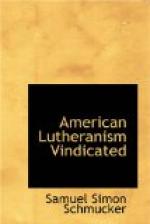(f) Dr. Sigismund J. Baumgarten of Halle, one of the most learned and profound divines that ever adorned the Lutheran church, who himself published one of the best and the most extensively circulated editions of the symbolical books in 1747, not only inserts the Directory for Baptism (which inculcates exorcism) among the symbolical books, but on p. 637 bears the following testimony: “The Directory for solemnizing marriage, as well as the following Directory for Baptism, are found in the oldest Corp. Doctrinae, in the Thuringian, Julian, Brandenburg, and first DRESDEN EDITIONS, and also subsequently, in the Leipsic and Reineccian,” p. 637.
From these historical testimonies the following points are clearly established:
1. That the Directory for Baptism, in which exorcism is prescribed, was certainly received into the first and authentic edition of the German Book of Concord, or collection of symbolical books. This is attested by Drs. Guericke, Sig. Baumgarten, and Koellner. It was subsequently republished in various other editions, down till the recent editions of Mueller, and also of Ludwig in our own country. In other editions [Note 3] it was omitted, because in some portions of Germany exorcism was rejected at an early day, as stated in the History of the American Lutheran Church.
2. It is proved that the practice of exorcism was for a long time regarded as a test of orthodoxy in many Lutheran territories of Germany. Attested by Drs. Augusti, Baumgarten Crusius and Siegel. In these countries editions of the symbolical books containing the Baptismal Directory were in use, and the rite was regarded as symbolical.
3. The rite was received and practised throughout Sweden, the entire kingdom of Wuertemberg, Hanover, Saxony, &c., &c. Siegel and others. [sic]
4. It is established incontestibly [sic] that the practice was continued for centuries in some of these countries, and was but recently renounced by others. Siegel and others. [sic]
We may therefore well affirm, that the position of the Definite Platform on this subject has been established beyond the possibility of serious doubt, namely, “That this rite was retained, with an altered interpretation, in various parts of the Lutheran Church in Europe for several centuries.” p. 23.




